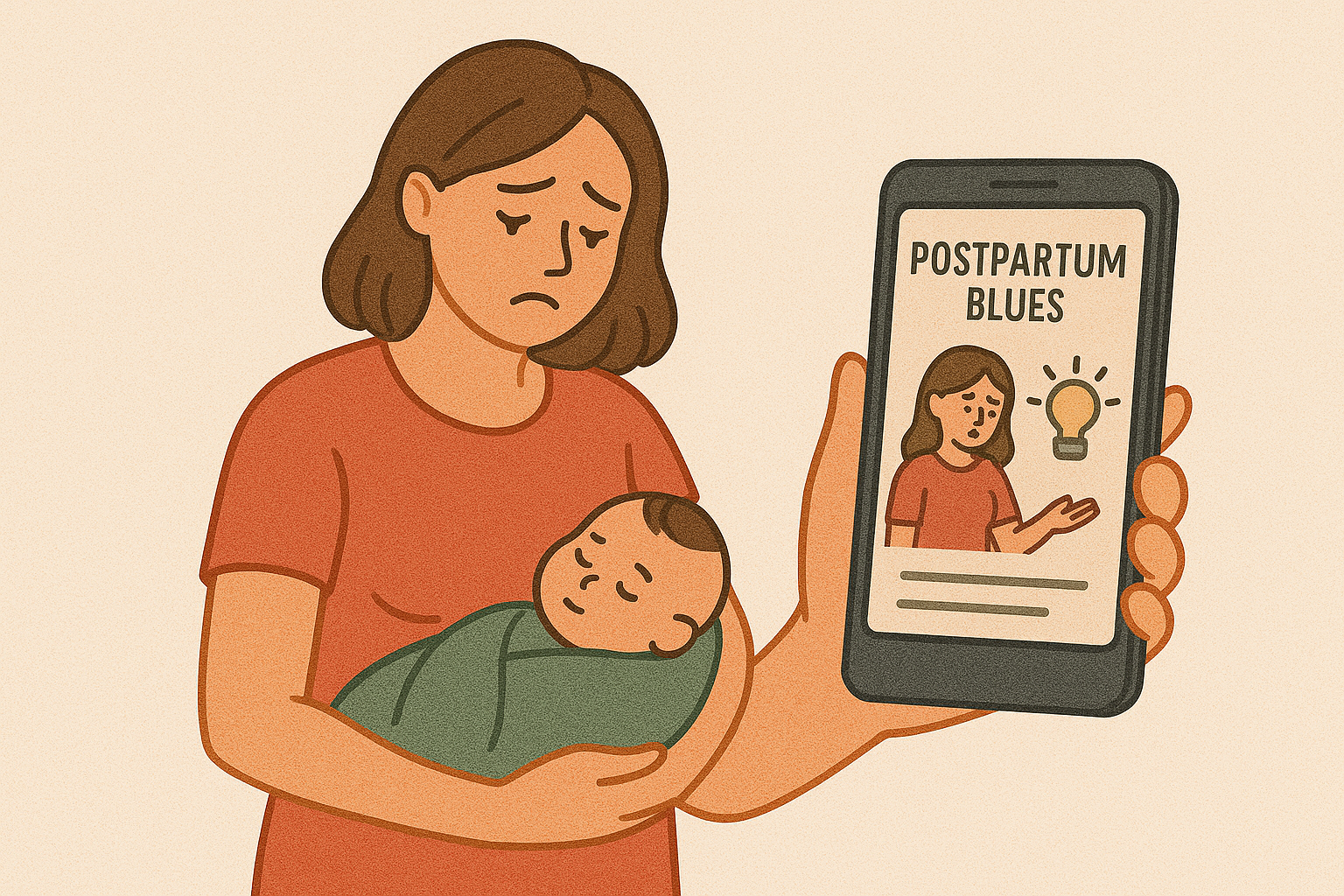THE EFFECT OF “BUFAS SMART” EDUCATION ON THE INCIDENCE OF POSTPARTUM BLUES AT RSUD KARTINI KARANGANYAR

Downloads
Abstract
Background: Postpartum blues, maternity blues or baby blues is a temporary mild mood/affect disorder that occurs on the first day to the 10th day after delivery. Postpartum blues usually occurs on the third or fourth postpartum day and peaks between the fifth postpartum day which is characterized by frequent crying, feelings of loneliness or rejection, anxiety, confusion, anxiety, fatigue, forgetfulness and sleeplessness. One of the preventive efforts through health promotion, one of the effective ways is by using social networks. BUFAS SMART is the name of the whatsapp group used to provide education to postpartum mothers conducted for 3 consecutive days on postpartum mothers on day 3 to day 5 in the intervention group with material containing how to care for babies, how to breastfeed, and psychological changes in postpartum women. Method: The sample of this study amounted to 50 respondents of postpartum mothers with purposive sampling technique. This research design uses quasy experiment. This research instrument uses a questionnaire. Data analysis used is Wilcoxon test and Mann-Whitney test. Result: The effect of “BUFAS SMART” education on the incidence of postpartum blues at Kartini Karanganyar Hospital on respondents in the intervention posttest group and control posttest group was significant with the results of the p-value <0.05, which is 0.000, meaning that there is a significant difference between the pretest and posttests of the control group. Conclusion: BUFAS SMART reduces the incidence of postpartum blues at Kartini Karanganyar Hospital, so the BUFAS SMAST education method is suitable for application in postpartum blues mothers add more in-depth knowledge about the postpartum period.
Ahyar, H., Maret, U. S., Andriani, H., Sukmana, D. J., & Mada, U. G. (2020). Buku Metode Penelitian Kualitatif & Kuantitatif (H. Abadi (ed.); Nomor April). Pustaka Ilmu.
Akinlabi, F. B., Olatunji, F. B., & Oluwayemisi, F. . (2013). Puerperium experience and adjustment identified psychological variables. Journal of Education Research and Behavioral Sciences, 2(12), 254–258.
Almida, E. N., Dahlia, Y., & Shammakh, A. A. (2023). Hubungan Usia Dan Paritas Terhadap Kejadian Baby Blues Syndrome Pada Ibu Postpartum Di Kecamatan Sambelia, Lombok Timur. Nusantara Hasana Journal, 2(11), 30-36.
American Psychiatric Assocition (2013). Diagnostic and statistical manual of mental disorder (5thedn), VA: Marecan Psychiatric Publishing Arlington.
Aritonang J SY. (2021). Asuhan Kebidanan Pada Masa Nifas. Yogyakarta: Deepublish.
Asih Y R. (2016). Buku Ajar Asuhan Kebidanan Nifas dan Menyusui. Jakarta Timur: TIM.
Astutik, R. y. (2015). asuhan kebidanan masa nifas dan menyusui. jakarta timur: cv. trans infi media.
Bukhari, A., Hidayanty, H., Daud, N. A., Bahar, B., & Mastuti, N. L. P. H. (2021). Pengaruh Edukasi Media Whatsapp Tentang Gizi Laktasi, Involusi Uteri, Dan Lochea Terhadap Pengetahuan, Sikap Dan Perilaku Ibu Nifas. Oksitosin: Jurnal Ilmiah Kebidanan, 8(1), 20-33.
Ernawati, D., Merlin, W. O., & Ismarwati, I. (2020). Kejadian Postpartum Blues pada Ibu Postpartum di RS PKU Muhammadiyah Yogyakarta. Jurnal Ners Dan Kebidanan (Journal of Ners and Midwifery), 7(2), 203-212.
Falasifah. (2014). Pengembangan Media pembelajaran berbentuk Leaflet berbasis Sejarah Lokal dengan Materi Pertempuran Lima Hari di Semarang pada Siswa Kelas XI IPS di SMA Negri 2 Pamalang. Skripsi –Tahun Ajaran 2013-2014.
Fernalia, F., Busjra, B., & Jumaiyah, w. (2019). Efektifitas Metode Edukasi Audiovisual terhadap Self Management pada Pasien Hipertensi. Jurnal Keperawatan Silampari, 3(1), 221-233. https://doi.org/10.31539/jks.v3il.770
Irawati, D., & Yuliani, F. (2014). Pengaruh Faktor Psikososial dan Cara Persalinan 68 Terhadap Terjadinya Post Partum Blues Pada Ibu
Kamel Boulos, M. N., Giustini, D. M., & Wheeler, S. (2016). Instagram and WhatsApp in health and healthcare: An overview. In Future Internet (Vol. 8, Issue 3). MDPI AG. https://doi.org/10.3390/fi8030037
KEMENKES RI. (2019). Panduan Pelayanan Paska Persalinan Bagi Ibu Dan Bayi Baru Lahir. Jakarta: KEMENKES RI.
Khanday, Dr. M. A., Lone, Dr. N., Sidiq, Dr. M., & Qureshi, Dr. A. H. (2022). Impact of oral health education regarding an e-leaflet on children - brushing and diet guide for children during the COVID-19 pandemic. International Journal of Applied Dental Sciences, 8(1), 206–208. https://doi.org/10.22271/oral.2022.v8.i1d.1428
Kumalasari, I., & Hendawati, H. (2019). Faktor Risiko Kejadian Postpartum Blues di Kota Palembang. JPP (Jurnal Kesehatan Poltekkes Palembang), 14(2), 91-96.
Kusuma, P. D. (2017). Karakteristik penyebab terjadinya depresi postpartum pada primipara dan multipara. Jurnal Keperawatan Notokusumo, 5(1), 36-45.
Machmudah. (2015). Gangguan Psikologis pada Ibu Postpartum; Postpartum Blues. Jurnal Keperwatan maternitas Vol 3(2): 118-125).
Manurung, S., Setyowati, S., Ginanjar, AS, Soesilo, TE, & Tyastuti, D. (2019). Pengembangan Item Skala Maternal Blues Suryani (MBS) pada masa antepartum melalui bonding attachment yang memprediksi postpartum blues. Klinik Enfermeria, 29, 752–9.https://doi.org/10.1016/j.enfcli.2019.06.013
Marwiyah, N., Suwardiman, D., Mutia, H. K., Alkarimah, N. A., Rahayu, R., Nuraeni, N., & Uzzakiyyah, I. (2022). Faktor Determinan yang Mempengaruhi terjadinya Postpartum Blues pada Ibu Nifas. Faletehan Health Journal, 9(01), 89-99.
Notoatmodjo, 2016. Metodologi Penelitian Kesehatan. Jakarta: Rineka Cipta. 2013.
Nurhamsyah, D., Mendri, N. K., & Wahyuningsih, M. (2015). Kesehatan Reproduksi Remaja (Krr) Di Fakultas Ilmu Sosial Dan Ekonomi Universitas Respati Yogjakarta. In Jurnal Keperawatan Respati (Vol. 2).
Pereira, A.P.E., Leal, M. D.C., Gama, S. G. N. D., Domingues, R. M. S. M., Schilithz, A. O. C., Bastos, M. H. Determining Gestational Age Based on Information From the Birth in Brazil Study. Methodological Issues 2014; 30(1): 1-12.
Pour. E. R., Aliyari, S., Farsi, Z., & Ghelich, Y. (2020). Comparing the effects of interactive and noninteractive education using short massage service on treatment adherence and blood pressure among patients with hypertension. Nursing and Midwefery Studies, 9(2), 68-76. https://doi.org/10.4103/nms.nms_82_19
Pulungan, P. (2020). Teori Kesehatan Reproduksi. In Yayasan Kita Menulis (p. 178). Yayasan Kita Menulis. Pillitteri, A. (2009). Maternal & Child Health Nursing: Care of the Childbearing & Childrearing Family. (seventh). London: Lippincott Williams & Wilkins.
Risnawati, & Susilawati, D. (2018). Gambaran Kejadian Post Partum Blues Pada Ibu Nifas di Kelurahan Nanggalo Wilayah Kerja Puskesmas Nanggalo Padang Tahun 2018. Jurnal Kesehatan Panca Bhakti
Lampung, Volume VI, No. 2, 57-67. P- ISSN 2338-0020 E- ISSN 2615-8604.
Rachmawati, A., Sari, D. J. E., & Yunita, N. (2019). Relationship of Personal Hygiene and Early Mobilization With Perineum Wound Healing. Jurnal Kebidanan, 9(2), 130. https://doi.org/10.31983/jkb.v9i2.4366.
Rahayuningsih, FB. (2021). Peningkatan Kualitas Hidup Ibu Nifas. Nas Media Pustaka.
Scott, S., & Kyle, T. R. (2009). Maternity and Pediatric Nursing. (T. Gibbson, Ed.). Philadelphia: Wolters Kluwer Health dan Lippincott Williams & Wilkins.
Setianingsih, N. J., Dewi, A. P. S., & Indriyastuti, H. I. (2021, December). Application Of Parenting Counseling By Whatsapp In Preventing Postpartum Blues During Pandemic Time Of COVID-19. In Prosiding University Research Colloquium (pp. 436-445).
Setiyani A, Sukesi, Esyuananik. (2016). Modul Bahan Ajar Cetak Kebidanan: Asuhan Kebidanan Neonatus, Bayi, Balita dan Anak Pra Sekolah. Jakarta: Pusdiknakes, Badan PPSDM, KEMENKES.
Silbert-Flagg, J., & Pillitteri, A. (2018). maternal & child health nursing care of the childbearing and childrearing family 8th edition. Philadelphia: Wolters Kluwer Health. ISBN 9781496348135.
Simkin P, Whalley J, Keppler A. (2008). Panduan Lengkap Kehamilan, Melahirkan Dan Bayi: Edisi Revisi. Jakarta: Arcan.
Sinabariba, M., Sinaga, D., & Marsalena, R. (2022). Gambaran Karakteristik dan Pengetahuan Ibu Nifas Tentang Postpartum Blues di Klinik Pratama SAM Kecamatan Medan Maimun Tahun 2021. HealthCaring: Jurnal Ilmiah Kesehatan, 1(1), 18-26.
Siringo-ringo, E. (2022). Hubungan Dukungan Suami Terhadap Kejadian Postpartum Blues Pada Ibu Primipara Di Wilayah Kerja Puskesmas Sigompul Kecamatan Lintong Nihuta Kabupaten Humbang Hasundutan. Jurnal Riset Rumpun Ilmu Kesehatan (JURRIKES), 1(2), 306-319.
Sugiyono, 2016. Metode penelitian kuantitatif, kualitatif dan R&D. BANDUNG: PT Alfabeta.
Sulistianingsih, A., & Hasyim, D. I. (2021). Pengaruh edukasi persalinan via whatsapp group terhadap pengetahuan ibu hamil menghadapi persalinan di kabupaten pringsewu. Jurnal Ilmiah Kesehatan, 10(2), 85-94.
Tambag, H. et al. (2018). ‘Perceived social support and depression levels of women in the postpartum period in Hatay, Turkey’, Nigerian Journal of Clinical Practice, 21(11), pp. 1525–1530. doi: 10.4103/njcp.njcp_285_17.
Tine Donsu, JD. (2017). Psikologi Keperawatan: Aspek Psikologi, Konsep Dasar Psikologi dan Teori Perilaku. Pustaka Baru Press Yogyakarta.
Tyarini, I. A., & Resmi, D. C. (2020). Pengaruh Dukungan Sosial Orang Terdekat Dalam Meminimalisir Peristiwa Dan Dampak Postpartum Pada Ibu Usia Muda (Literatur Review). Jurnal Ilmiah Kesehatan, 10(1), 48-55.
Wiknjosastro GH. Ilmu kebidanan sarwono prawirohardjo. PT Bina Pustaka Sarwono Prawirohardjo, Jakarta.
Copyright (c) 2025 Tri Wikuncoro Tunggal Saputri, Luluk Fajria Maulida, Rufidah Maulina, Siti Nurhidayati, Ika Sumiyarsi Sukamto

This work is licensed under a Creative Commons Attribution-ShareAlike 4.0 International License.
1. The journal allows the author to hold the copyright of the article without restrictions.
2. The journal allows the author(s) to retain publishing rights without restrictions
3. The formal legal aspect of journal publication accessibility refers to Creative Commons Atribution-Share Alike 4.0 (CC BY-SA).
This Journal (e-ISSN 2656-7806) is licensed under a Creative Commons Attribution-ShareAlike 4.0 International License.
















